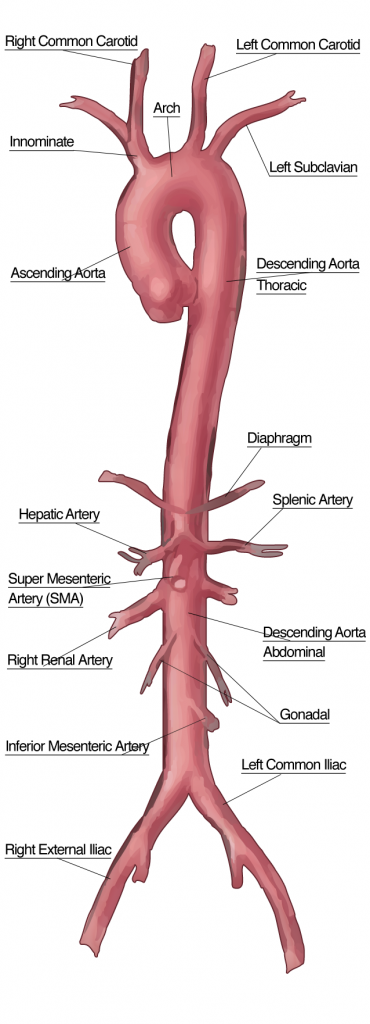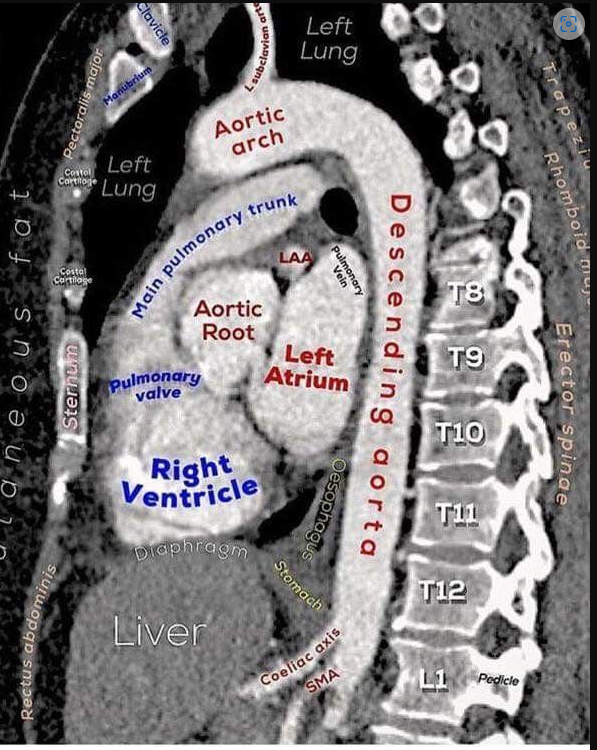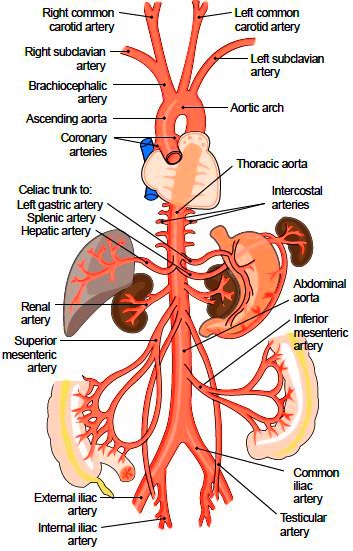Makindo Medical Notes"One small step for man, one large step for Makindo" |
|
|---|---|
| Download all this content in the Apps now Android App and Apple iPhone/Pad App | |
| MEDICAL DISCLAIMER: The contents are under continuing development and improvements and despite all efforts may contain errors of omission or fact. This is not to be used for the assessment, diagnosis, or management of patients. It should not be regarded as medical advice by healthcare workers or laypeople. It is for educational purposes only. Please adhere to your local protocols. Use the BNF for drug information. If you are unwell please seek urgent healthcare advice. If you do not accept this then please do not use the website. Makindo Ltd. |
The Aorta
-
| About | Anaesthetics and Critical Care | Anatomy | Biochemistry | Cardiology | Clinical Cases | CompSci | Crib | Dermatology | Differentials | Drugs | ENT | Electrocardiogram | Embryology | Emergency Medicine | Endocrinology | Ethics | Foundation Doctors | Gastroenterology | General Information | General Practice | Genetics | Geriatric Medicine | Guidelines | Haematology | Hepatology | Immunology | Infectious Diseases | Infographic | Investigations | Lists | Microbiology | Miscellaneous | Nephrology | Neuroanatomy | Neurology | Nutrition | OSCE | Obstetrics Gynaecology | Oncology | Ophthalmology | Oral Medicine and Dentistry | Paediatrics | Palliative | Pathology | Pharmacology | Physiology | Procedures | Psychiatry | Radiology | Respiratory | Resuscitation | Rheumatology | Statistics and Research | Stroke | Surgery | Toxicology | Trauma and Orthopaedics | Twitter | Urology
Related Subjects: |Aorta |Acute Coronary Syndrome (ACS) General |Aortic Dissection |Acute Heart Failure and Pulmonary Oedema |Aortic Regurgitation (Incompetence) |Aortic Stenosis |Aortic Sclerosis |Transcatheter aortic valve implantation (TAVI)
The aorta is the largest artery in the human body, originating from the left ventricle and extending to the abdomen where it divides into the iliac arteries. It is the main highway of oxygenated blood, distributing it to all organs. Its elasticity allows it to maintain constant perfusion during the cardiac cycle. 🫀
🧩 Anatomy of the Aorta
- Ascending Aorta:
- Begins at the aortic valve.
- Gives rise to coronary arteries ❤️ supplying the myocardium.
- Aortic Arch:
- Curves over the heart.
- Branches: 🟦 Brachiocephalic trunk → right arm & head, 🟥 Left common carotid → head/neck, 🟩 Left subclavian → left arm.
- Embryology link: Derived from pharyngeal arch arteries.
- Descending Thoracic Aorta:
- Travels through the chest (behind the heart & lungs).
- Supplies oesophagus, bronchi, ribs, spinal arteries.
- Abdominal Aorta:
- Begins at diaphragm → ends at L4 bifurcation.
- Branches:
- 🌟 Celiac trunk → foregut
- Superior mesenteric → midgut
- Renal arteries → kidneys
- Inferior mesenteric → hindgut
- Bifurcates into common iliac arteries → pelvis & legs.

📸 Lateral Radiology

⚙️ Functions of the Aorta
- Oxygenated Blood Distribution: main conduit to systemic circulation.
- Pressure Reservoir: elastic recoil maintains blood flow during diastole.
- Pulse Dampening: smooths the heart’s pulsatile output into steady flow.
- Pulse Wave Velocity: increases with stiffening (arteriosclerosis), used clinically.
🚨 Clinical Relevance
- 🔴 Aortic Aneurysm:
- Dilation, usually abdominal (AAA) or thoracic (TAA).
- Risk factors: hypertension, smoking, connective tissue disease (Marfan, Ehlers–Danlos).
- Screening: 🧑 >65 males offered ultrasound in UK.
- Rx: surveillance, stent graft (EVAR), or open repair.
- 🩸 Aortic Dissection:
- Tear in intima → false lumen formation.
- Stanford A (ascending) vs Stanford B (descending).
- Severe “tearing” chest/back pain, unequal arm BPs.
- Emergency: IV β-blockers + urgent surgery for Type A.
- 🟤 Atherosclerosis:
- Plaque → stiffness, turbulence, embolisation risk.
- Linked to coronary artery disease, PAD, stroke.
- Risk factors: cholesterol, diabetes, smoking.
- Managed by statins, BP control, lifestyle change.
- 🍼 Coarctation of the Aorta (congenital):
- Narrowing, usually distal to left subclavian.
- Findings: radio-femoral delay, hypertension in arms, rib notching on X-ray.
- Rx: balloon angioplasty or surgical repair.
- ⚖️ Aortic Valve Disorders:
- Aortic stenosis (calcific, bicuspid valve) → LV outflow obstruction.
- Aortic regurgitation → volume overload.
- Both can cause heart failure; often need valve replacement.
📝 Summary
The aorta is central to systemic circulation. Its structure (ascending, arch, descending, abdominal) maps directly to the territories it supplies. Pathology ranges from aneurysm and dissection to congenital defects and valve disease. 👉 Always consider screening, risk factor control, and early recognition of emergencies (rupture, dissection).
📷 Anatomy
